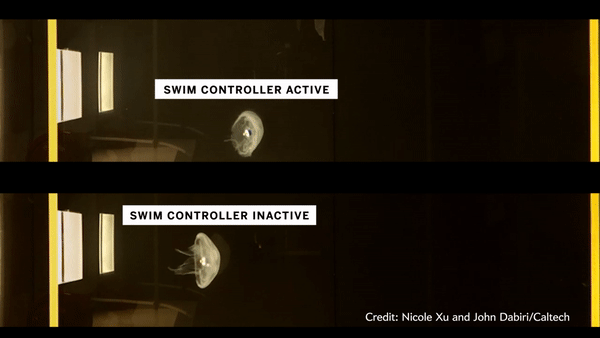This artist illustration shows what the robotic-hybrid jellyfish look like.
Rebecca Konte/Caltech
From CNET by Amanda Kooser
They're like regular jellyfish, but faster and more awesome.
Darth Vader and RoboCop now have some cyborg company in the form of superpowered jellyfish. Researchers at the California Institute of Technology have developed a swim controller that turns regular jellyfish into speed demons.
The device enhances a jellyfish's natural pulsing motion that it uses to move around in the water.
"The new prosthetic uses electrical impulses to regulate -- and speed up -- that pulsing, similar to the way a cardiac pacemaker regulates heart rate," Caltech said in a release on Wednesday.
Researchers fitted some moon jellyfish with a prosthetic “swim controller”
Credit: Nicole Xu and John Dabiri Caltech
The electronic swim controller made the modified jellyfish swim nearly three times faster than their normal speed
Credit: Nicole Xu and John Dabiri Caltech
The electronic swim controller made the modified jellyfish swim nearly three times faster than their normal speed
Credit: Nicole Xu and John Dabiri Caltech
The microelectronic prosthetic propels the cyborg jellyfish to swim almost three times faster while using just twice the metabolic energy of their unmodified peers.
The prosthetics can be removed without harming the jellyfish.
The research team published its findings in the journal Science Advances on Wednesday.
The scientists aren't making superpowered jellies just for fun.
The cyborg invertebrates could potentially carry sensors into the ocean to gather data from otherwise hard-to-reach locations.
Engineers at Caltech and Stanford University have developed a tiny prosthetic that enables jellyfish to swim faster and more efficiently than they normally do, without stressing the animals.
The researchers behind the project envision a future in which jellyfish equipped with sensors could be directed to explore and record information about the ocean.
The Navy funded a jellyfish-inspired robot project in 2012, but the biohybrid approach has some advantages.
The cyborgs don't have the power limitations of full-on robots and don't need to be tethered to an external power source.
"If we can find a way to direct these jellyfish and also equip them with sensors to track things like ocean temperature, salinity, oxygen levels, and so on, we could create a truly global ocean network where each of the jellyfish robots costs a few dollars to instrument and feeds themselves energy from prey already in the ocean," said Caltech engineer and research lead John Dabiri.
It sounds like sci-fi, but an army of cyborg jellies may play a role in the future of ocean exploration and monitoring.
Links :



No comments:
Post a Comment